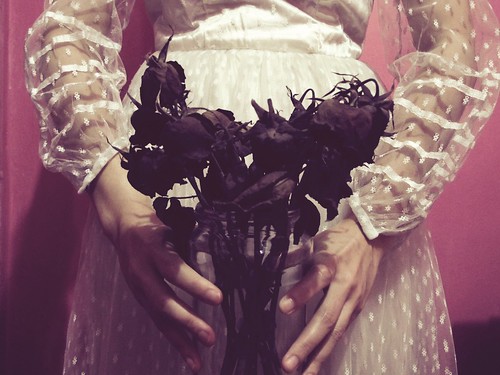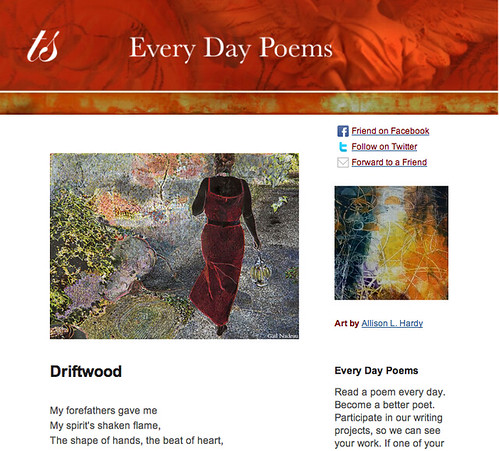Horror, repulsion, bafflement. These were strange emotions for me in a place that normally signified beauty and order and peace.
I had walked right into the same art museum I had visited a hundred times. Usually, I would go up the stairs one level, pass by the front desk, and head directly into the European art hall. On a normal visit, Gauguin’s Pont Aven collection summons me siren-style, then I wander forwards and backwards to Cezanne, Pissaro, Monet.
But on one particular summer day, I decided not to treat the art museum as my own private collection. I walked into the less familiar galleries to look at art from different traditions, other sensibilities, continents where my ancestors had never traveled.
The Asian gallery was cool and dark and subdued. Several scrolls hung rolled out, meticulous brush strokes depicting mountains and sky and sea, forming words that looked like houses and gates and bridges. These looked like the scrolls that hang in my writing studio, purchased from street artists in poor cities in China. They weren’t as unfamiliar as I expected.
But as I entered the African gallery, a giant mask hung provocatively before me. The straw hair hung like a grass skirt, the face appearing as a man, a dog, and a crocodile all at the same time. I turned away, a little disgusted, but all around me I saw more masks, crude statues, clothing with drawings of animals and trees. The crocodile mask wasn’t a one-off cultural anomaly; it was part of a tradition. A tradition I knew so little about.
I forced myself to pause a moment in front of several of the pieces, each in its turn, admiring the craftsmanship. It called to mind history and I considered the rituals of a culture that included art and representation and imaginative storytelling. I read the descriptions next to the glass cases and discovered that many of these items were more contemporary than I expected, and most were part of transition ceremonies that moved boys and girls through life, into adulthood and marriage and parenting and old age. Eventually, to death.
I thought of my own life and its lack of transition. My own spiritual tradition ritualizes very few rites of passage: birth, marriage, childbirth, and death. Our larger culture celebrates only a few other markers: driving at 16 and drinking at 21. I marked 18 by voting, though many bypass that rite. Friends gathered when I turned 30 and 40. But transition? Not really.
“Much of traditional African art is concerned with the communal desire for all members of society to proceed safely through life transitions, ” one of the placards read. Surely I share that desire with the communities I am a part of. But do I mark it and celebrate it for myself, for others? Especially for those, like me, who may pass from childhood into adulthood in less traditional ways, who have matured through years of singleness rather than in marriage and parenthood.
I left the African art gallery and turned the corner into a special exhibit of modern American fashion. The juxtaposition was stark. In bright and airy lighting, thin, aloof mannequins sported creations from designers Norell, Blass, Halston & Sprouse. There were day dresses and evening dresses, suits and coats. Some of the designs looked destined to go no farther than the runway; others were styles I’ve worn myself.
Some of the patterns were repulsive, some horrifying. Yet the artistry and craftsmanship were unmistakable. Not much of a fashionista, I forced myself to take it in, to stand and observe, to read and learn. I saw dresses worn at inaugural balls and dresses marking significant career moments for the rich and famous among us.
Then, I thought of the evening gowns I wore to my high school proms, the day dress I wore to my college graduation, the suits I wore to job interviews.
Perhaps I was proceeding safely after all.
Photo by cameracarrie, Creative Commons via Flickr. Post by Charity Singleton.
__________________
Buy a year of Every Day Poems, just $2.99— Read a poem a day, become a better poet. In September we’re exploring the theme The Poet.
- Grammar for a Full Life Book Club: On Becoming Less Possessive - June 16, 2021
- Grammar for a Full Life Book Club: Chilling Out on the Grammar Rules - June 9, 2021
- Grammar for a Full Life Book Club: A Passive Voice - June 2, 2021


Will Willingham says
Charity, smiling at how this came around to fashion at the end (because that’s my thing, right?). I’m just thinking that in many ways, for me, I’m in the very same place I was 20 years ago. (With a few garments, quite literally 😉
Charity Singleton says
I’m right there with you. My first thought was that this juxtaposition revealed a shallowness about our culture. But the more I thought about it, how we present ourselves within our cultures and communities has much to say about life’s transitions. I’m thinking now even of the red hat ladies.
Monica Sharman says
You, too? I still have (for example) a nice rayon shirt my brother gave me when I was in 9th grade. 🙂
Maureen Doallas says
Wonderful that you crossed a threshold in that art museum and began to see with “new” eyes.
Charity Singleton says
Maureen – I think this post is about experiencing and learning from art as it is about fashion or transitions. Imagine what a different experience I would have had if the African art had been next to classical sculpture, or American painters? I probably need to reach out to the museum director and tell her what this particular layout produced in me.
L.L. Barkat says
Time to go clothes shopping? 🙂
I, too, was fascinated by the idea of clothing being connected to rites of passage.
Could it be more intentional, I wonder? (Of course, you writing about it is already a type of intention, which I love 🙂
Charity Singleton says
Laura – yes, the fashion industry does lack a bit of intention when marking life’s milestones. In fact, many use fashion to resist aging or moving through life. I wonder all the time if I’m dressing “too young” or “too old.” We probably all know people who hide behind clothing.
Perhaps our problem is that our garments are too literal and less symbolic? Or perhaps we value individuality over community? I think these questions speak to this issue of intention, which admittedly is lacking. And the curators placement of the exhibits may also have lacked all of this intention I am reading into it.
Donna says
Wow I never thought of it this way, but you are so perceptive. Our culture is not what one would call “overly demonstrative” when it comes to formally recognizing transitions at all. We are not all that forgiving as a whole for even ACKNOWLEDGING them! Our motto seems to be “buck up” or “get over it” or “that’s life” or “walk it off”. Lots to think about here. Thank you, Charity.
And … 40% off at Christopher Banks today! LOL! Online and in stores. I mention this bc this is my FAVORITE STORE and when it closed here I thought it went out of business… I have been sadly transitioning to JC Penney and Macy’s short-ladies departments. So when I received the email I felt I had to SHARE THE GOOD NEWS!!!
Charity Singleton says
Donna – I think you hit on what I was craving as I looked at crude (IMHO) masks and statues. I would love for a blessing or pronouncement or even an acknowledgement that despite setbacks and difficulties, I am making my way pretty well in this world and have what it takes to thrive in the next stage. Our cult of youthfulness keeps us in constant denial that death is any closer today than it was yesterday, I know it’s not true, and I think acknowledging it collectively would help us all.
Donna says
Charity… so so so much here. And yes, I think it would help us all, too. Truly acknowledging transitions requires slowing down and stepping off the hamster wheel though and so unless one is willing to (or shoved off) it’s hard to see what is happening, what is missed, what is held, and even that so many of us house such a feeling of an un-nameable lacking. I guess now I will never look at an artifact like this in the same way again.
Will Willingham says
Funny, Donna. 🙂 Have to say, though, the “short-ladies” department would be the very last place you’d find me.
Donna says
🙂
Monica Sharman says
Intentional clothing can sometimes be way off, culturally. When I got married, I chose a business-suit pattern for my bridesmaids’ dresses so that they could use it again after the wedding. Functionality over appearance, that’s generally me. 🙂
Laura says
You have me thinking about traditions, Charity. I grew up in a family in which one day was much like the next– no special days noted. It makes remembering tricky. I want to make a different way, to celebrate even the tiniest of markers. I wonder if this is good or bad?